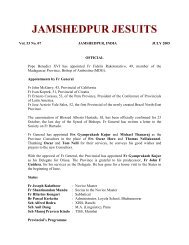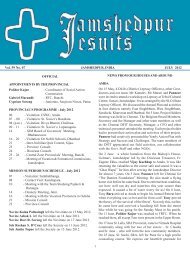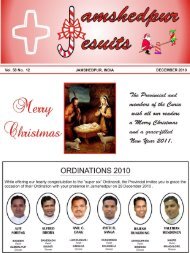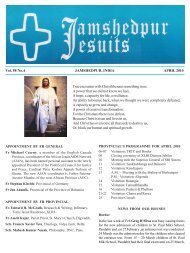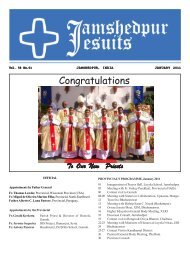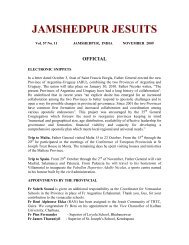Click here to download - Jamshedpur Jesuits
Click here to download - Jamshedpur Jesuits
Click here to download - Jamshedpur Jesuits
You also want an ePaper? Increase the reach of your titles
YUMPU automatically turns print PDFs into web optimized ePapers that Google loves.
Roots<br />
By Hedwig Lewis, SJ<br />
“Confraternities” have been in<br />
existence in the Church since the Middle<br />
Ages in all parts of Europe. Their<br />
main purpose was mutual aid <strong>to</strong> their<br />
own members, within some religious<br />
framework. By the early 16th century,<br />
new confraternities, especially in Venice<br />
and Rome, shifted their emphasis from<br />
mutual aid <strong>to</strong>ward charity <strong>to</strong> needy nonmembers.<br />
Jesuit involvement<br />
When Ignatius and his companions<br />
first arrived in Rome, confraternities were<br />
numerous and established entities. In<br />
1541 Ignatius joined two Confraternities<br />
– of the Blessed Sacrament and of<br />
the Holy Spirit, for spiritual benefits,<br />
like indulgences granted <strong>to</strong> members.<br />
But t<strong>here</strong> is no evidence of his active<br />
participation in these. The early <strong>Jesuits</strong><br />
joined confraternities, but in keeping<br />
with Ignatius’ policy they did not take<br />
up administrative positions for fear that<br />
their availability for ministry would<br />
be compromised (Const 651). They<br />
collaborated with existing confraternities,<br />
helping “reform” them, and founding new<br />
ones. They promoted a deeply interiorized<br />
ethical and religious life, and infused the<br />
spirit of the Spiritual Exercises.<br />
The first Jesuit confraternity was<br />
founded in 1539-1540 by Peter Faber<br />
in Parma. Members, both priests and<br />
laymen, bound themselves <strong>to</strong> spiritual<br />
duties and <strong>to</strong> works of charity, instructions<br />
in Christian doctrine, and assistance<br />
<strong>to</strong> criminals condemned <strong>to</strong> death. The<br />
confraternity <strong>to</strong>ok the name Compagnia di<br />
Gesu. Within a short time some members<br />
joined this ‘Society of Jesus’.<br />
St Ignatius himself founded a<br />
confraternity in Rome in the 1540s of<br />
twelve pious men, <strong>to</strong> collect alms at the<br />
sermons of the Fathers in the Chapel of<br />
Our Lady of the Wayside and distribute<br />
these among the poor. He also founded<br />
three specific confraternities, which apart<br />
from spiritual practices, respectively<br />
attended <strong>to</strong> the houses of S. Marta for<br />
reformed prostitutes; of S. Caterina della<br />
Rosa for the daughters of prostitutes; and<br />
of catechumens, mainly Jews and Muslims<br />
who wished <strong>to</strong> convert <strong>to</strong> Catholicism.<br />
First Marian Sodality<br />
The Roman College founded<br />
by St Ignatius in 1551, enrolled Jesuit<br />
Ignatian Initiatives<br />
for the Laity:<br />
Confraternities<br />
& Sodalities<br />
scholastics and externs from all of Europe.<br />
A 27-year-old Belgian Jesuit, Jan Leunis<br />
(1535-1584), recently ordained, was<br />
appointed in 1662 <strong>to</strong> teach grammar<br />
t<strong>here</strong> <strong>to</strong> the junior classes. He had about<br />
250 students. In 1563 Fr Leunis, wanting<br />
<strong>to</strong> inculcate “habits of conduct worthy<br />
of a Christian” in extern students (see<br />
Const 395), formed a group of about 70<br />
interested students which met after school<br />
hours for spiritual reading and prayer.<br />
At first the group resembled existing<br />
confraternities.<br />
Within a year, however, it <strong>to</strong>ok<br />
on a Marian character and the name of<br />
‘Sodaility of Our Lady.’ The boys placed<br />
themselves under the patronage of the<br />
Virgin Mary, and promised <strong>to</strong> make it <strong>to</strong><br />
daily Mass, weekly confession, monthly<br />
Communion, as well as <strong>to</strong> a half-hour<br />
meditation every day, and <strong>to</strong> also “serve<br />
the poor”. It was the forerunner and<br />
distinct model of all Sodalities of Our<br />
Lady that it would give rise <strong>to</strong>. Unlike<br />
confraternities, the sodality did not have a<br />
particular dress, functioned privately, with<br />
less stringent bonds among members,<br />
and by greater freedom of action and<br />
expansion<br />
A circular letter of 14 July 1564<br />
from Rome <strong>to</strong> the Whole Society<br />
described the nature and composition<br />
of the new institution, adding that “one<br />
of the Fathers directs” it, even though<br />
from among “the older and wiser” boys<br />
a prefect was elected. This signalled a<br />
shift in the earlier Jesuit policy regarding<br />
such bodies.<br />
Expansion<br />
The Sodality became so popular<br />
that students from other classes sought<br />
membership. In 1569 it split in<strong>to</strong> two,<br />
according <strong>to</strong> age-groups. Soon t<strong>here</strong> was<br />
a third division. The original group was<br />
referred <strong>to</strong> as the Prima Primaria Sodality,<br />
(the very first of the three primaries).<br />
The <strong>Jesuits</strong> were glad <strong>to</strong> support the<br />
initiative and soon Sodalities were started<br />
in their schools across Europe, especially<br />
motivated by those who had studied at the<br />
Roman College. They eventually became<br />
an integral part of the newly started<br />
education system.<br />
In 1578 Fr General Claudio<br />
Aquaviva issued “Common Rules” for<br />
the Sodalities, which were operative for<br />
nearly three centuries, and proved <strong>to</strong> be<br />
an important corners<strong>to</strong>ne for the dynamic<br />
developments of Marian Congregations<br />
worldwide.<br />
In 1584, Pope Gregory XIII<br />
confirmed the Prima Primaria Sodality<br />
as the Head of all Marian Congregations,<br />
in his Bull Omnipotentis Dei. As the<br />
first lay association in the Church, it was<br />
granted the right of self-government,<br />
though juridically, sodalities came under<br />
the General Superior of the Society of<br />
Jesus. In 1587 Pope Sixtus V, in his Bull<br />
Superna Dispositione, provided rights<br />
<strong>to</strong> the Jesuit General <strong>to</strong> create sodalities<br />
among Christian laity universally, which<br />
could be affiliated <strong>to</strong> the Prima Primaria,<br />
and enjoy the privileges and indulgences<br />
granted <strong>to</strong> it. Soon, Marian Sodalities<br />
aggregated <strong>to</strong> the “Prima Primaria” were<br />
mushrooming by the thousands. Several<br />
Popes and numberless canonized saints<br />
have belonged <strong>to</strong> sodalities over the<br />
centuries.<br />
In 1954 the World Federation<br />
of the Sodalities of Our Lady (Marian<br />
Congregations) was born. In Oc<strong>to</strong>ber<br />
1967, during the 4th Assembly of the<br />
Federation, the final draft of the new<br />
General Principles, developed through a<br />
worldwide consultation, was approved by<br />
the 140 delegates from 38 countries. This<br />
marked a re-founding of the Sodalities:<br />
they were given a new name, Christian<br />
Life Communities.<br />
•<br />
JIVAN: News and Views of <strong>Jesuits</strong> in India OCTOBER 2012 19



